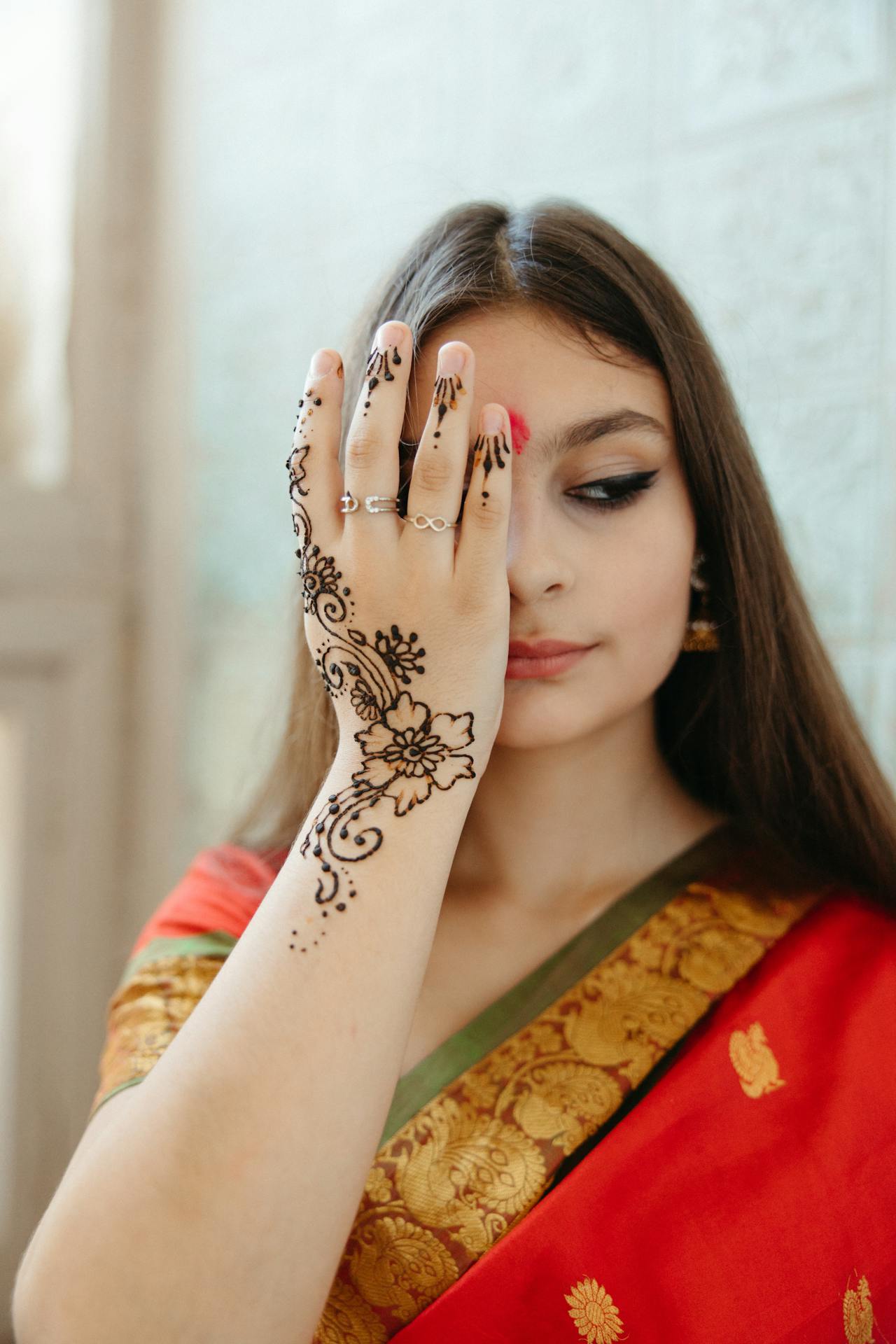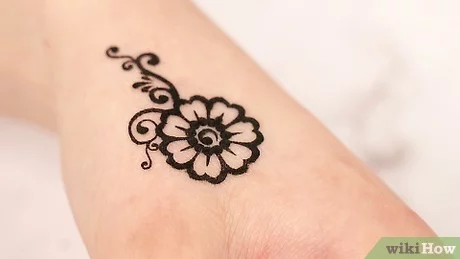
What is Henna?

Henna is..
While the term “henna” is tied to many cultures and religions, it’s most predominant in India where it’s known as mehndi. Shaily Savla, a henna tattoo expert based in Los Angeles, explains that henna is a crucial part of many Indian celebrations, including Diwali, engagements, and weddings. The henna itself is a temporary dye that has gained popularity for its beauty, but among Indian culture, it’s considered more of a ritual. “There is often a dedicated event for the bridal parties to have their mehndi applied,” says Savla. “There’s a saying that the darker the mehndi is, the stronger the marriage will be.”
Henna
Henna paste is made from a powder derived from the henna plant. It’s been used for centuries as a natural dye for hair and nails, and now its most well-known use is for body art. The temporary dye has—and still is—most popularly used to adorn women and men as part of their marriage celebrations.
How Long Henna Lasts
Those unfamiliar with the practice may question if henna tattoos are permanent, and while they are temporary, there are a few factors that go into the longevity of them. Savla says, “Once applied, it’s said the longer you leave it on to absorb into the skin, the darker it will be. The darker it is, the longer it will last.” She also explains how the placement of the henna will also play a role in how long it lasts. “Hands and feet, which are used often and exposed to water and soap, might start fading away after one week and fully disappear at two weeks,” she notes. “Placement on the back or upper arm have potential to last an additional week or two.”
Common Placements of Henna Tattoos
Like an ink tattoo, henna can be applied almost anywhere on the body, albeit certain locations hold more significance than others. For instance, henna tattoos placed on the palms have been said to allow the person to be able to receive and offer blessings. Also, the physical feeling of getting a henna tattoo plays a role. According to Savla, “Henna has a natural cooling effect when applied, which is said to have nerve-calming properties before the wedding day when placed on the hands and feet.” She adds that one would usually get the darkest color on the warmer parts of the body—especially the palms. “Commonly, the designs people get on their palms are the most intricate, and sometimes draw out a story using symbols and illustrations of the bride and groom,” she notes.
:max_bytes(150000):strip_icc():format(webp)/hennabydivya_1569077115_2137896254727248396_1293605818-02dd240a8af84852821c2d3f8c2de34a.jpg)
On the flip side, when henna is applied on the top of the hands, it suggests protection—traditionally, brides get their mehndi adorned all the way up to their elbows. Savla says that its designs are usually not as elaborate as the palms—it’s more spaced out and bold (for example, a mandala at the center with vines or the same design down all the fingers).
Aside from the hands, the feet are also a spiritual place to get henna. “Just like the hands, getting henna on the feet is said to help cool the nerves with its herbal remedies,” says Savla. “Designs on the feet vary but usually share the same aesthetic as the designs done on the hands.” And, using religious symbols and designs on the feet may be disrespectful to the culture or religion.
:max_bytes(150000):strip_icc():format(webp)/hennabybianchi_1588614621_2301788730812114268_2033161495-2d5a478988cb426a829f7c044dff6e7a.jpg)
Popular Henna Design Ideas and Meanings
If you’re new to the world of henna tattooing, you may be overwhelmed with your options. Below, Savla describes 14 different henna tattoo designs—along with their meanings—that you can’t go wrong with.
- Sahasrara: “This is a lotus-like symbol that represents unity, and is most commonly seen on the palms.”
- Peacock: “As the national bird in India, peacocks represent beauty and their feathers are believed to bring prosperity. Birds also signify the link between heaven and earth. Placement is commonly on the hands and back.”
- Dragonflies and butterflies: “These creatures are said to represent transformation or rebirth and new beginnings.”
- Paisley designs: “These mango-shaped designs are versatile and can be decorated in many ways on the inside and outside of the design. The origin of the shape symbolizes luck with fertility, but has now become a staple design and symbol in Indian fashion and art. Placement of the paisley can be commonly seen on the hands and feet.”
- Flowers: “Flowers are common designs, as they represent beauty and new beginnings, with the most popular being the lotus flower. It’s a symbol of grace, purity, and heart. Common placement for flowers is on the hands and back.”
- Vines and leaves: “These represent strength and longevity. The most common placement is on the fingers.”
- Eyes: “An eye or evil eye symbol reflects protecting one from any evil thoughts or wishes. They’re most commonly seen on the hand or back of the neck.”
- Snakes and lizards: “These are not as popular in traditional henna designs, but they are known to represent seekers of enlightenment.”
- Om: “The om symbol is a well-known spiritual symbol or mantra that broadly refers to the self and universal spirit. It’s often adorned as a statement piece with designs around it, and is commonly placed on the hand, arms, and back.”
- Circles: Not only are round circles striking, but they’re representative of the cycle of life and the fulfillment of destiny. Circles in henna can be designed in various ways, from dotted lines with empty spaces to bold, ink-filled orbs.
- Golecha: Golecha is a natural dye that’s often heavily saturated, and most commonly seen in tones of red. The result offers a bold look.
- Moroccan: Moroccan henna designs are known for their geometric shapes and their ability to be worn by any gender. This tribal style often covers the entire hand.
Henna Tattoo Aftercare
While there are a few things you can do to help your henna tattoo last longer, they typically last for three to four weeks. After about 10 to 15 days, you can expect the dye to start fading, but before then it should have a strong color and opacity. Below are some care instructions for your henna.
- Don’t touch it after application. Once it’s applied, let the henna set for about 30 minutes to ensure it’s dry and resistant to smudging.
- Apply a protective seal. According to Dr. Divya Shokeen, a board-certified dermatologist in California, after the henna has dried, apply a sugar-lemon mixture or a special henna sealant over the design to protect it from smudging or fading.
- Avoid water. Dr. Shokeen advises you to keep the henna design dry for at least six to eight hours after application to allow the pigment to set properly. Avoid exposure to water during this period. So, cover it up while you’re showering, bathing, or doing dishes.
- Avoid chemicals. Steer clear of salt water, harsh chemicals (including hand sanitizer), and chlorine.
- Keep it moisturized. Like a self-tanner, henna requires hydration to prolong longevity. “Regularly moisturize the henna tattooed area to prevent the skin from drying out and prolong the vibrancy of the design,” says Dr. Shokeen.
Henna Tattoo Removal
Ready to remove your henna? Exfoliation is the name of the game here. Try buffing the remnants away with a pumice stone or loofah and a good body scrub. Or, mix a cup of olive oil with a few tablespoons of sea salt and apply the blend to the henna—this can help lift the dye from the skin. For an alternate approach, Dr. Shokeen suggests a more acidic route. She adds that by gently exfoliating with AHAs, you’ll be able to slough off the top layers of skin where the henna is located. “Be gentle to avoid irritation!”
Cost of Henna Tattoos
Henna tattoos are typically far less expensive compared to ink-based tattoos done with a gun or stick and poke tools—both of which can cost anywhere from $100 to $1000 depending on the size and where you go. Henna can cost as little as five dollars at fairs and craft shows. For larger pieces and more intricate designs, they can get pricier, but still nowhere near what a permanent tattoo can cost. Savla also notes that the experience and skill of the henna artist plays a role as well. “Skilled artists are quick and have mastered freehand drawing, as that is a lot of what henna is,” she says. “But, if there’s a specific design requested—as in a symbol—it could cost about $20.” For bridal henna tattoos, it can take anywhere from four to eight hours to apply, and that would cost anywhere from $250 to $1000 depending on your artist and difficulty of design.
Potential Side Effects of Henna
According to Dr. Shokeen, “Some individuals may experience allergic reactions to henna, leading to symptoms like redness, itching, or swelling.” While an allergic reaction could be the body’s natural reaction to even premium henna products, less than reputable formulations could exacerbate this and even result in chemical sensitivity. Savla notes that while most henna pastes include natural ingredients to elevate the natural colors, black henna—a type of henna that’s been laced with a harmful substance to make it darker and last longer—has gained recognition over the years. These additives can pose major risks to the skin in the form of chemical burns and allergic reactions.1 “Henna products may contain additives or chemicals that can cause skin irritation in sensitive individuals. Opt for natural, pure henna to minimize this risk,” echoes Dr. Shokeen.
Skin irritation is another possible side effect, usually resulting from user error in removal attempts.
“Leaving henna on for an extended period or using abrasive substances to remove it can result in skin irritation or damage,” explains Dr. Shokeen. “Avoid leaving henna on for too long and choose gentle removal methods.”
Transform Your Look with Custom Henna Tattoos
Our custom henna tattoos are designed to transform your look and express your unique style with stunning artistry.


DJANGO
DJANGO
DJANGO
DJANGO